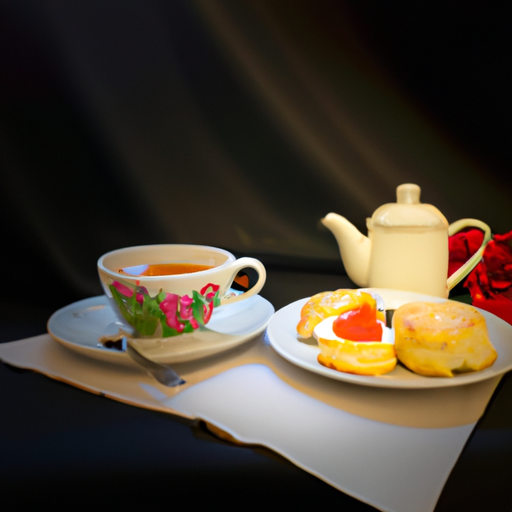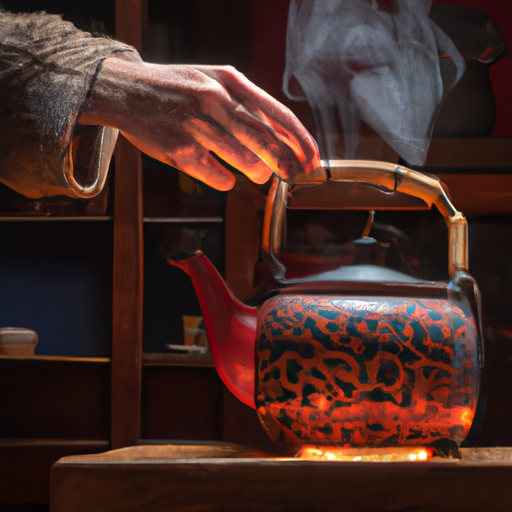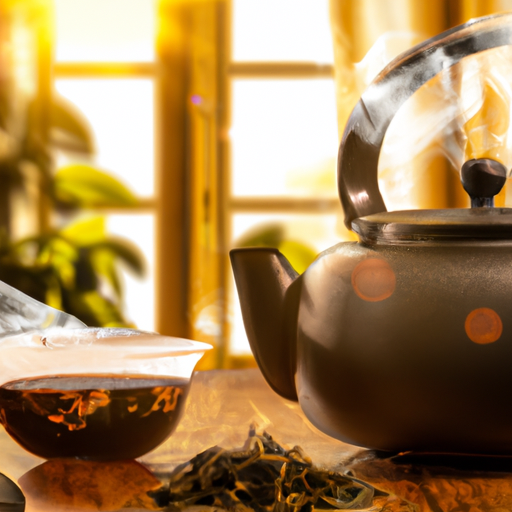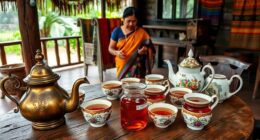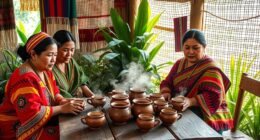Have you ever wondered how to give your furry friend a healthy boost for their skin and coat? Look no further! I’m here to share with you a wonderful holistic secret – the art of making skin and coat herbal tea for dogs.
Just like how we humans enjoy a soothing cup of tea, our canine companions can also benefit from the natural goodness of herbs. By incorporating this simple yet effective practice into your dog’s routine, you can enhance their overall skin and coat health in a natural and gentle way.
So, let’s dive into the world of herbal remedies and discover the perfect blend of herbs that will leave your dog’s fur looking shiny and their skin feeling nourished. Get ready to brew up some magic for your four-legged friend!
Key Takeaways
- Herbal tea for dogs can promote a healthy skin and coat.
- Common herbs used in skin and coat herbal teas for dogs are chamomile, nettle, calendula, and burdock root.
- These herbs have various benefits such as soothing itchy skin, reducing inflammation, promoting wound healing, and improving overall coat condition.
- When making the tea, use high-quality ingredients and brew it by boiling water, adding the herbal tea blend, steeping, straining, and cooling it before introducing it to your dog slowly.
Benefits of Herbal Tea for Dogs
There’s no denying the numerous benefits of herbal tea for dogs. Not only does it promote a healthy skin and coat, but it also provides a range of other health benefits.
Herbal teas are packed with antioxidants and anti-inflammatory properties that can improve your dog’s overall well-being. They can help soothe irritated skin, reduce itching and redness, and even alleviate certain skin conditions. Additionally, herbal teas can boost the immune system, aid in digestion, and calm anxiety in dogs.
When it comes to choosing the right herbs for your dog, it’s important to consider their specific needs and any existing health conditions. Some common herbs used in skin and coat herbal teas for dogs include chamomile, nettle, calendula, and burdock root.
Chamomile has calming properties and can help soothe itchy skin, while nettle is known for its anti-inflammatory effects. Calendula is great for promoting wound healing and reducing skin irritation. Burdock root is beneficial for dogs with dry skin and can help improve coat condition.
By incorporating the right herbs into your dog’s herbal tea, you can address their specific skin and coat issues. So, let’s explore the world of herbal teas and discover the perfect blend for your furry friend.
Choosing the Right Herbs for Your Dog
When it comes to choosing the right herbs for your dog, there are a few key points to consider.
Calendula is a great option for promoting skin health, as it has anti-inflammatory properties and can help with wound healing.
Nettle is another herb to consider, as it can improve coat condition by reducing shedding and promoting a healthy, glossy coat.
And if your dog suffers from irritation or allergies, chamomile is a soothing herb that can help relieve discomfort.
Calendula for Skin Health
Calendula, known as the ‘sunshine herb,’ can work wonders for your furry friend’s skin, leaving it as vibrant and radiant as a summer sunset. This versatile herb has been used for centuries for its healing properties.
Calendula is known for its anti-inflammatory and antimicrobial effects, making it an excellent choice for various skin conditions in dogs. Here are some emotional benefits of using calendula for your dog’s skin health:
-
Soothing: Calendula’s gentle nature can provide relief for itchy and irritated skin, bringing comfort to your beloved pet.
-
Nourishing: This herb can deeply moisturize and nourish the skin, promoting a healthy and lustrous coat.
-
Healing: Calendula’s ability to promote wound healing can help your dog’s skin recover faster from cuts, scratches, or irritations.
Now, let’s dive into the next section about nettle for coat condition.
Nettle for Coat Condition
Imagine how soft and silky your furry friend’s coat could be with the help of nettle, an herb known for its amazing benefits for coat condition. Nettle tea, made from the leaves of the nettle plant, is a natural remedy that can promote a healthy and shiny coat in dogs.
The benefits of nettle tea for dogs include reducing shedding, soothing skin irritations, and improving overall coat health. To make nettle tea for your four-legged companion, simply steep a handful of dried nettle leaves in hot water for about 10 minutes, strain, and let it cool before serving. You can add a splash of honey or a few drops of coconut oil for added flavor and nourishment.
The nettle tea recipe is simple and effective, providing your dog with the nutrients needed for a luscious coat. Now, let’s explore how chamomile can help soothe skin irritations.
Chamomile for Soothing Irritation
To soothe irritations, simply brew a cup of chamomile tea and gently apply it to your furry friend’s sensitive areas. Chamomile has been used for centuries for its medicinal properties, and it can work wonders for your dog’s skin.
Chamomile is known for its anti-inflammatory and calming effects, making it perfect for soothing any irritation your dog may be experiencing. To make chamomile tea, steep one chamomile tea bag or a tablespoon of dried chamomile flowers in a cup of hot water for about 10 minutes. Let it cool down before applying it to your dog’s skin.
Chamomile benefits not only include soothing irritations, but it can also help with allergies and promote healthy skin and coat. Now that you know the benefits of chamomile, let’s move on to gathering and preparing the ingredients for our skin and coat herbal tea for dogs.
Gathering and Preparing the Ingredients
First, gather all the necessary ingredients for making the skin and coat herbal tea for dogs. When it comes to gathering tips, it is important to choose high-quality ingredients that are safe and beneficial for your furry friend. Herbal teas can provide numerous benefits for a dog’s skin and coat, such as reducing irritation and promoting a healthy shine. For this particular tea, you will need dried chamomile flowers, dried nettle leaves, dried calendula petals, and dried rosemary. These ingredients work synergistically to soothe the skin, reduce inflammation, and nourish the coat.
To highlight the importance of these ingredients, consider the following table:
| Ingredient | Benefits |
|---|---|
| Chamomile flowers | Soothes irritation |
| Nettle leaves | Promotes healthy coat growth |
| Calendula petals | Reduces inflammation |
| Rosemary | Nourishes the coat |
Once you have gathered all the ingredients, you are ready to move on to the next step: brewing the skin and coat herbal tea for your beloved dog. By brewing this tea, you can provide a natural, nourishing solution to support your dog’s skin and coat health.
Brewing the Skin and Coat Herbal Tea
Little did the tea connoisseurs know that their expertise in brewing a perfect cup of tea could also be applied to creating a soothing elixir for our four-legged friends. When it comes to brewing the skin and coat herbal tea for dogs, it’s important to follow certain brewing techniques to ensure maximum benefits.
First, bring a pot of water to a boil and then turn off the heat. Add the herbal tea blend to the water, allowing it to steep for about 5-10 minutes. This steeping time ensures that all the beneficial properties of the herbs are extracted into the tea. Afterward, strain the tea to remove any loose herbs and let it cool down to room temperature.
Now that the tea is brewed, it’s time to introduce it to your dog. Begin by offering a small amount to your dog and observe their reaction. Some dogs may take to the tea immediately, while others may need some time to adjust to the taste. You can mix the tea with your dog’s regular food or water to make it more appealing. Gradually increase the amount of tea offered to your dog over a few days, ensuring they are comfortable with it.
With these brewing techniques and the right steeping time, your dog can enjoy the benefits of this soothing elixir.
Introducing the Tea to Your Dog
Now that you’ve brewed this soothing elixir, it’s time to introduce it to your furry friend and watch their reaction. When introducing the skin and coat herbal tea to your dog, it’s important to do it slowly and monitor their reaction.
Start by offering them a small amount of the tea, diluted with water, to see how they respond. Some dogs may be hesitant at first, so be patient and give them time to get used to the new taste.
Observe your dog closely as they drink the tea. Look for any signs of discomfort or adverse reactions such as vomiting, diarrhea, or excessive scratching. If you notice any of these symptoms, stop giving them the tea immediately and consult with your veterinarian.
On the other hand, if your dog enjoys the tea and shows no negative reactions, you can gradually increase the amount over time.
Remember, every dog is different, and what works for one may not work for another. It’s always best to introduce new supplements or herbal remedies slowly and carefully.
Transitioning to the next section about additional tips for skin and coat health, it’s important to consider other factors that contribute to your dog’s overall well-being.
Additional Tips for Skin and Coat Health
To enhance the health of your furry friend’s fur and give them a shine like a diamond, consider incorporating these additional tips into their routine. Regular grooming is essential for maintaining a healthy skin and coat. Brushing your dog’s fur helps to distribute natural oils and remove any loose hair or debris. This not only keeps their coat looking shiny, but also helps to prevent matting and skin irritations.
Additionally, bathing your dog with a gentle, dog-specific shampoo can help to keep their skin clean and free from any allergens or irritants.
In addition to grooming, it’s important to provide your dog with a balanced diet that supports skin and coat health. Ensure that their food contains a good balance of proteins, healthy fats, and essential vitamins and minerals. Omega-3 fatty acids, found in fish oil or flaxseed oil, can also be beneficial for promoting a healthy coat and reducing inflammation.
Remember, a healthy skin and coat starts from within. By incorporating these tips for grooming dogs at home and providing a balanced diet, you can help your furry friend achieve a beautiful and glossy coat. Now, let’s move on to answering some frequently asked questions about herbal tea for dogs.
Frequently Asked Questions about Herbal Tea for Dogs
Are you curious about the benefits and safety of incorporating herbal tea into your dog’s routine?
Herbal tea can be a great addition to your dog’s diet, providing numerous benefits for their skin and coat health. However, there are some common misconceptions and potential side effects to be aware of when it comes to herbal tea for dogs.
-
Herbal tea is safe for most dogs: When prepared properly and given in moderation, herbal tea can be a safe and natural way to improve your dog’s skin and coat health. However, it’s important to consult with your veterinarian before introducing any new supplements or herbs to your dog’s diet.
-
Not all herbs are safe for dogs: While many herbs have beneficial properties, there are some that can be toxic to dogs. It’s crucial to research and ensure that the herbs used in the tea are safe for canine consumption.
-
Potential side effects: Some dogs may experience digestive upset or allergic reactions to certain herbs. It’s important to monitor your dog closely for any adverse reactions and discontinue use if necessary.
By understanding these common misconceptions and potential side effects, you can make an informed decision about whether herbal tea is the right choice for your dog’s skin and coat health. Remember to always consult with your veterinarian before making any changes to your dog’s diet or introducing new supplements.
Frequently Asked Questions
Can herbal tea for dogs help with other health issues besides skin and coat health?
Yes, herbal tea for dogs can work wonders! It can help with allergies, soothing itchy skin and promoting a shiny coat. It can also improve digestion, making your pup feel better from the inside out.
Are there any potential side effects or risks associated with giving herbal tea to dogs?
When it comes to giving herbal tea to dogs, there are potential risks and safety concerns to consider. It’s always best to consult with a veterinarian before introducing any new ingredients into your dog’s diet.
Can I use dried herbs instead of fresh herbs for making the skin and coat herbal tea?
Using dried herbs for skin and coat herbal tea for dogs offers convenience and longevity. Plus, herbal tea provides various benefits beyond skin and coat health, like improving digestion and boosting the immune system.
How long will it take to see improvements in my dog’s skin and coat after giving them herbal tea?
Improvements in my dog’s skin and coat health can vary. It may take a few weeks to notice changes after giving them herbal tea. Consistency is key, and results can be enhanced by a balanced diet and regular grooming.
Can I mix the skin and coat herbal tea with my dog’s regular food or water?
Yes, you can mix the skin and coat herbal tea with your dog’s regular food or water. It’s a great way to enhance their dry food with the benefits of the herbal tea, promoting a healthy skin and coat.
Conclusion
In conclusion, incorporating herbal tea into your dog’s routine can have a profound impact on their skin and coat health. By carefully selecting and brewing the right combination of herbs, you can enhance their natural beauty from the inside out.
Remember, consistency is key when introducing any new element to your dog’s diet, so start slow and gradually increase their tea intake. With patience and persistence, you’ll witness the powerful effects of this holistic approach, promoting a shinier, smoother, and softer coat for your beloved furry friend.


